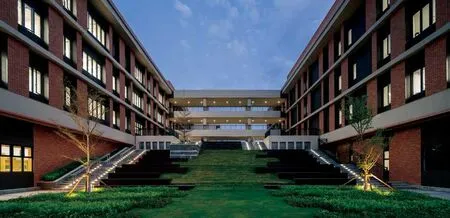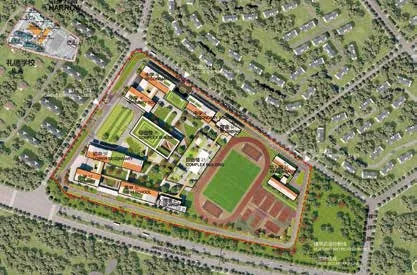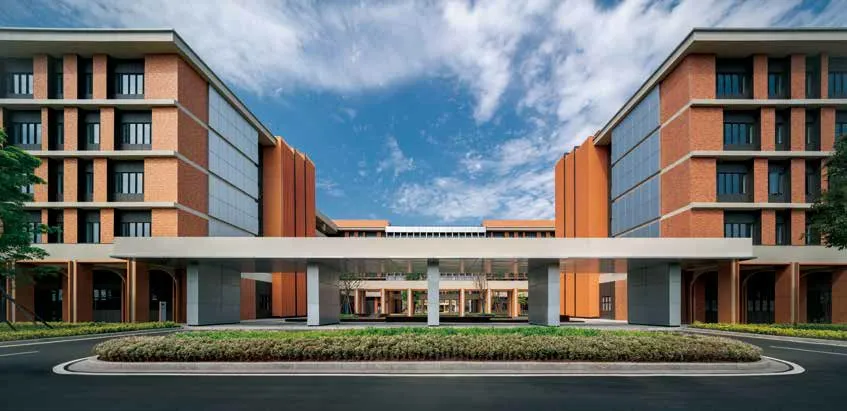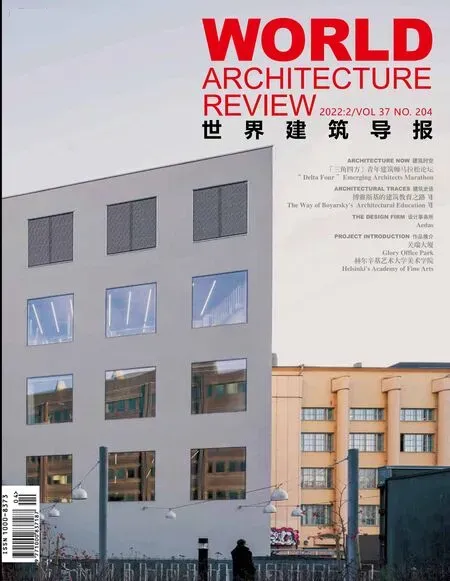哈羅國際學校及禮德學校中國海口
項目建筑師:Aedas
業主:海口市城市建設投資有限公司
建筑面積:60 895平方米
竣工年份:2020年
主要設計人:柳景康,執行董事
攝影:CreatAR Images
Architect: Aedas
Client: Haikou Urban Construction & Investment Co., Ltd.
Gross Floor Area: 60 895 sq m
Completion Year: 2020
Design Director: Cary Lau, Executive Director
Photography: CreatAR Images
半開放式氛圍重新定義校園
Aedas為英國有著百年歷史的名校哈羅公學在海口打造了兩所國際學校——哈羅國際學校(Harrow International School)及禮德學校(Harrow Innovation Leadership Academy)。這是確定建立海南自由貿易港后,首家落戶海南的國際知名教育品牌,更是自由貿易試驗區江東新區的第一個項目。
作為海南省會的海口市有著“椰城”別稱,椰風海韻,風光旖旎,宜人的氣候與熱帶的海濱美景使其成為重要的旅游城市,而構建自由貿易港的絕佳契機,也使其一躍成為極具吸引力的海濱度假勝地與商業中心。
項目位于海口江東區,地理位置優越,地塊占地約96,673平方米,最多將可容納約1,800名學生,提供從幼兒園至高中12年級的國際雙語教育。設計需在同一地塊打造出哈羅國際學校及其全新雙語學校品牌禮德學校兩所不同的學校建筑,在空間共享中,營造出鼓勵探索的學習環境。
為確保總體規劃滿足學校需求的同時與學校特色完美融合,設計采用緊湊連續的布局方式,將哈羅國際學校置于地塊北側邊界,禮德學校置于地塊南側邊界,兩者之間設有共享設施,如游泳池、餐廳,以確保雙方均可便捷使用,而運動場位于教學樓東側,方便學生自由進入。
由于兩所學校均包含幼兒園、小學、中學、宿舍和員工宿舍多種功能,設計采用兩排平行建筑彼此連接的形式,構建無縫連接的教學街區,形成內部庭院,為學生提供大量開放的活動空間。并在兩所學校靠邊界一側打造獨立入口,將兩座教學樓之間的空間形成極具識別性的大門。
設計將兩所學校的禮堂頂部打造成為綠色平臺,通過空中走廊即可進入,并打造了階梯式露臺。圍繞教室設置了大量開放綠色空間,形成明確的室內外劃分,營造出充滿活力的校園氛圍。
校園的一大亮點是融入海口當地建筑特色的半開放式教學建筑,設計沿教學樓設置廊柱通廊模擬騎樓空間,巧妙地將兩所學校串聯起來,形成容納更多交流活動的公共空間,提升學生間的互動。
設計以不同的立面細節與輪廓特征彰顯學校身份。哈羅國際學校采用紅棕色陶磚,以現代優雅的立面呼應英國本部的經典山墻造型,而禮德學院則采用淺紅色陶磚,以輕快簡潔的造型反映其年輕品牌調性。
“我們希望這個項目能夠重新定義校園,創造出一個有助于互動學習的環境氛圍,為整個地區的高質量教育樹立一個新標桿。”Aedas執行董事柳景康如是說。
First to Lead Hainan’s Global Educational Vision
Aedas has recently completed two international schools in Haikou for the British educational brand Harrow. It’s the first among a list of eminent names to be introduced to Hainan, following the province’s rise as a free trade port and its commitment to be a leading education hub in the region.
Haikou, also known as the "Coconut City", is the capital city of Hainan Province. Situated in the tropics, steeped in serene coastal scenery and a pleasant climate, Haikou has evolved from a sightseeing city to an attractive seaside resort and business centre.
Strategically located in Jiangdong District, Haikou, the Harrow International School and Harrow Innovation Leadership Academy (ILA) are set on a site of 96,673 sq m to provide Kindergarten to 12th grade international and bilingual education for a maximum of 1,800 students. The design objective for this project is to create two distinct school buildings with ample shared spaces, and foster a learning environment that encourages exploration.
The two schools—Harrow and its younger brand ILA—are both comprised of kindergarten, primary and secondary schools, dormitories and staff quarters. The Harrow school is located along North boundary, and the ILA along the south, each with two rows of connected teaching blocks to create abundant courtyards and open space for students. Each school has an independent entrance which is identified by the open space between two teaching blocks on the front row.
To ensure the overall layout meets users’ demands and aligns with the schools’ features, the master plan arranges the blocks in a compact and continuous manner. There are shared facilities,such as a swimming pool and dining hall, set between the two schools to ensure equal access;while the sports ground in the east sprawls before the two institutions that also allows easy mean of entry.
Each school is furnished with green decks and stepping terraces, designed on top of the auditoriums. These open spaces are purposely placed adjacent to classrooms, accessible via overhead corridors. This measured configuration of functions, as well as the clearly delineated indoor-outdoor relationships, help engender a vibrant educational environment.
A unique character of the campus is the semi-open design of the school buildings, deriving from an architectural feature endemic to Haikou, the verandas. Accompanied with covered passage and communal streets, they enhance social engagement and serve as a totem for Haikou culture.
The design for the two schools are coherent, with each of their own distinctive facade details:classic red bricks on the Harrow International School echo England’s architectural tradition in a modern and elegant style, while the lighter red on the ILA lend the edifice a brisk, clean facade that reflects its position as the younger brand.
“Through creating an inviting environment for interactive learning, we hope this project will recontextualise, and set a new benchmark for high-quality education across the region.” — Aedas Executive Director Cary Lau.







